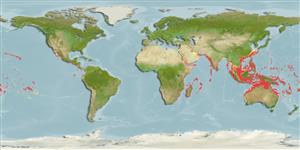Common names from other countries
Environment: milieu / climate zone / depth range / distribution range
Ecology
Marine; reef-associated; depth range 3 - 150 m (Ref. 9281). Tropical; 30°N - 35°S, 29°E - 70°W
Indo-Pacific: in tropical waters, from South Africa to Hawaii and Easter Island, north to southern Japan and south to Lord Howe Island. Eastern Pacific: Revillagigedo, Clipperton and Cocos islands (Ref. 9281).
Size / Weight / Age
Maturity: Lm ? range ? - ? cm
Max length : 51.0 cm NG male/unsexed; (Ref. 89467); max. published weight: 1.8 kg (Ref. 89467)
Dorsal spines (total): 0; Dorsal soft rays (total): 96 - 104; Anal spines: 0; Anal soft rays: 74 - 81. Eyed side with dark margined light colored spots and numerous scattered small dark spots; normally with 3 dark blotches or spots on lateral line; dorsal and anal fins with longitudinal row of widely-spaced dark spots; pectorals of the eyed side with dark crossbars (Ref. 4417).
Inhabit sandy bottoms of coastal coral reefs (Ref. 5213, 48637), generally in shallow water (Ref. 9281). Benthic (Ref. 58302). Hunt mostly at night, but also active during the day. Often crawling over low rocky reef (Ref. 48637). Occasionally rest on bare rock (Ref. 1602). Feed on fishes, crabs and shrimps. Collected by divers (Ref. 9824).
Life cycle and mating behavior
Maturities | Reproduction | Spawnings | Egg(s) | Fecundities | Larvae
Hensley, D.A., 1986. Bothidae. p. 854-863. In M.M. Smith and P.C. Heemstra (eds.) Smiths' sea fishes. Springer-Verlag, Berlin. (Ref. 4417)
IUCN Red List Status (Ref. 130435)
CITES (Ref. 128078)
Not Evaluated
Threat to humans
Harmless
Human uses
Fisheries: commercial; aquarium: commercial
Tools
Can't connect to MySQL database fbquizv2. Errorcode: Too many connections
